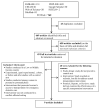Emergency Transportation Interventions for Reducing Adverse Pregnancy Outcomes in Low- and Middle-Income Countries: A Systematic Review
- PMID: 33262936
- PMCID: PMC7678559
- DOI: 10.5334/aogh.2934
Emergency Transportation Interventions for Reducing Adverse Pregnancy Outcomes in Low- and Middle-Income Countries: A Systematic Review
Abstract
Objective: To assess the effect of emergency transportation interventions on the outcome of labor and delivery in low- and middle-income countries (LMICs).
Methods: Eleven databases were searched through December 2019: Medline/PubMed, EMBASE, Web of Science, EBSCO (PsycINFO and CINAHL), SCIELO, LILACS, JSTOR, POPLINE, Google Scholar, the Cochrane Pregnancy and Childbirth Group's Specialized Register, and the Cochrane Central Register of Controlled Trials. Methodological quality of included studies was assessed using the ROBINS-I tool.
Results: Nine studies (three in Asia and six in Africa) were included: one cluster randomized controlled trial, three controlled before-and-after (CBA) studies, four uncontrolled before and after studies, and one case-control study. The means of emergency obstetric transportation evaluated by the studies included bicycle (n = 1) or motorcycle ambulances (n = 3), 4-wheel drive vehicles (n = 3), and formal motor-vehicle ambulances (n = 2). Transportation support was offered within multi-component interventions including financial incentives (n = 1), improved communication (n = 7), and community mobilization (n = 2). Two controlled before-and-after studies that implemented interventions including financial support, three-wheeled motorcycles, and use of mobile phones reported reduction of maternal mortality. One cluster-randomized study which involved community mobilization and strengthening of referral, and transportation, and one controlled before-and-after that implemented free-of-charge, 24-hour, 4 × 4 wheel ambulance and a mobile phone showed reductions in stillbirth, perinatal, and neonatal mortality. Six studies reported increases in facility delivery ranging from 12-50%, and one study showed a 19% reduction in home delivery. There was a significant increase of caesarian sections in two studies; use of motorcycle ambulances compared to car ambulance resulted in reduction in referral delay by 2 to 4.5 hours. Only three included studies had low risk of bias on all domains.
Conclusion: Integrating emergency obstetric transportation with complimentary maternal health interventions may reduce adverse pregnancy outcomes and increase access to skilled obstetric services for women in LMICs. The strength of evidence is limited by the paucity of high-quality studies.
Copyright: © 2020 The Author(s).
Conflict of interest statement
The authors have no competing interests to declare.
Figures
References
-
- Wardrop AA, Popaduik NE. Women’s experiences with postpartum anxiety: Expectations, relationships and sociocultural influences. Qual Rep. 2013; 18: 1–24.
Publication types
MeSH terms
LinkOut - more resources
Full Text Sources



